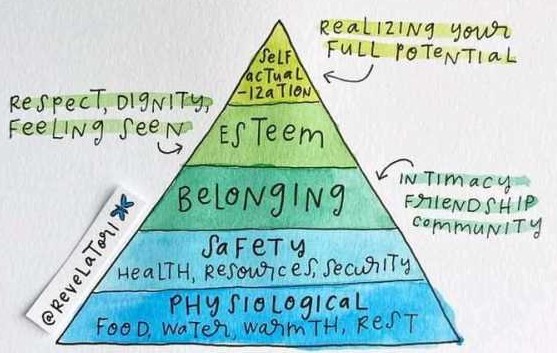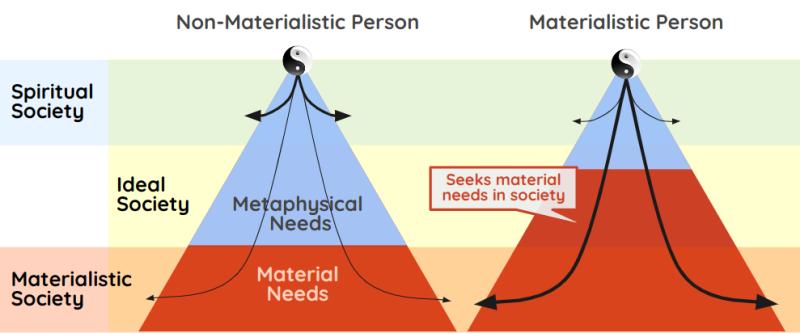Replacing Utility with a Flexible Hierarchy of Needs
Table of Contents
The Doctrine of Utility
The lack of fellow feeling in Economics makes it focus on the self and usefulness or “utility” that our selves get, through goods and services.
This makes utility-for-the-self the core doctrine in Economics.
- The aethereal part is the self
- the material part is the tangible or visible goods and services
This makes Economics materialistic and selfish. This then leads to the producer’s motive.

In contrast, Supereconomics uses fellow-feeling as its basis.
This reduces its focus on material utility whle increasing its focus on the utility that other people can get. This is consistent with Adam Smith and Socrates seeing excessive riches as dangerous:
Power and riches.. are enormous machines that produce a few trifling conveniencies to the body..ready every moment to burst into pieces and crush their unfortunate possessor..
Adam Smith
Theory Of Moral Sentiments, Part 4
Smith was against having utility as the basis of any economy because utility does not build fellow-feeling and therefore does not build morality.
It is not this utility which is the principal source of our approbation.. It seems impossible that we would approve of virtue in the same way we approve of a well-made building.. The sentiment of approbation that arises from the beauty of utility has no reference to the sentiments of others.
Adam Smith
Theory Of Moral Sentiments, Part 4
In other words, utility or material usefulness is only morally good for the self. When you pursue material things, you only think of yourself and your own needs.
For example, you might be very hungry and want to eat at an Indian restaurant, but your partner, also very hungry, might want to eat at a Korean restaurant.
- If you really wanted to maximize our utility, then you would eat separately.
- But if you want to maximize your mutual love, then one of you will sacrifice your needs for that of the other.
When you pursue material things, you only think of yourself and your own needs
According to Adam Smith, humans should think of the needs of others. This mutual feeling would then lead to the wealth of nations through trade.
Selfishness, Utility, Maslow’s Needs
Selfisness leads to a focus on material utility which Maslow enshrined as the “physiological needs”.
These physiological needs are the most pre-potent of all needs. In the human being who is missing everything in life in an extreme fashion, it is most likely that the major motivation would be the physiological needs rather than any others. A person who is lacking food, safety, love, and esteem would most probably hunger for food more strongly than for anything else.
Abraham Maslow
Maslow assumes an uncaring society as the default. This then leads to the lack of food.
And so he says that food is most pre-potent of all needs.
This is easily disproven by breatharians who can live without eating.
To build a supereconomic system that has fellow feeling and redced material needs, we put Maslow’s Hierarchy under the 5 Elements Model.

This allows us to make the higher needs like love and self-actualization larger and more important than the physiological ones (which might only have a temporal importance).
For example, a person can have a much larger self-actualization with very little physiological needs, as seen in breatharians.
Or right after they meet their basic material needs, they can go straight to love and self-actualization.
The first and greatest of necessities is food, which is the condition of life and existence. The second is a dwelling. The third clothing and the like.. Each will bring the result of his labours into a common stock.. All things are produced more plentifully and easily when one man does one thing which is natural to him.
Socrates
The Supereconomic Hierarchy of Needs
Our 5 Elements model:
- allows a society to have flexible needs
- gives importance to self actualization while not neglecting the material needs.
In our model:
- The upper parts of the pyramid represent the metaphysical needs of the soul. This includes svadharma
- The lower parts of the pyramid represent the material needs of the physical body. This includes food, shelter, clothing
The focus of the soul goes down the pyramid as it addresses the needs of the soul and body.
- What it cannot get by itself, it tries to get through others.
This it does by offering what it can, based on its skills, abilities, and personal qualities.

- A materialistic society only caters to the material needs. It might have an abundance of material goods for sale, ecommerce, cryptocurrencies. But it is deficient in spritual ideology or even cultural practices.
- A spiritual society has strong spritual ideology and rich traditional culture. But it might be materially backward.
- An ideal society is one that can satisfy all the hierarchal needs of every human, neglecting neither materiality nor spirituality.
Since svadharma or self-purpose is aethereal in nature, and since it is the cause of value-creation, then this model supports the abstract mechanism of wealth createion directly.